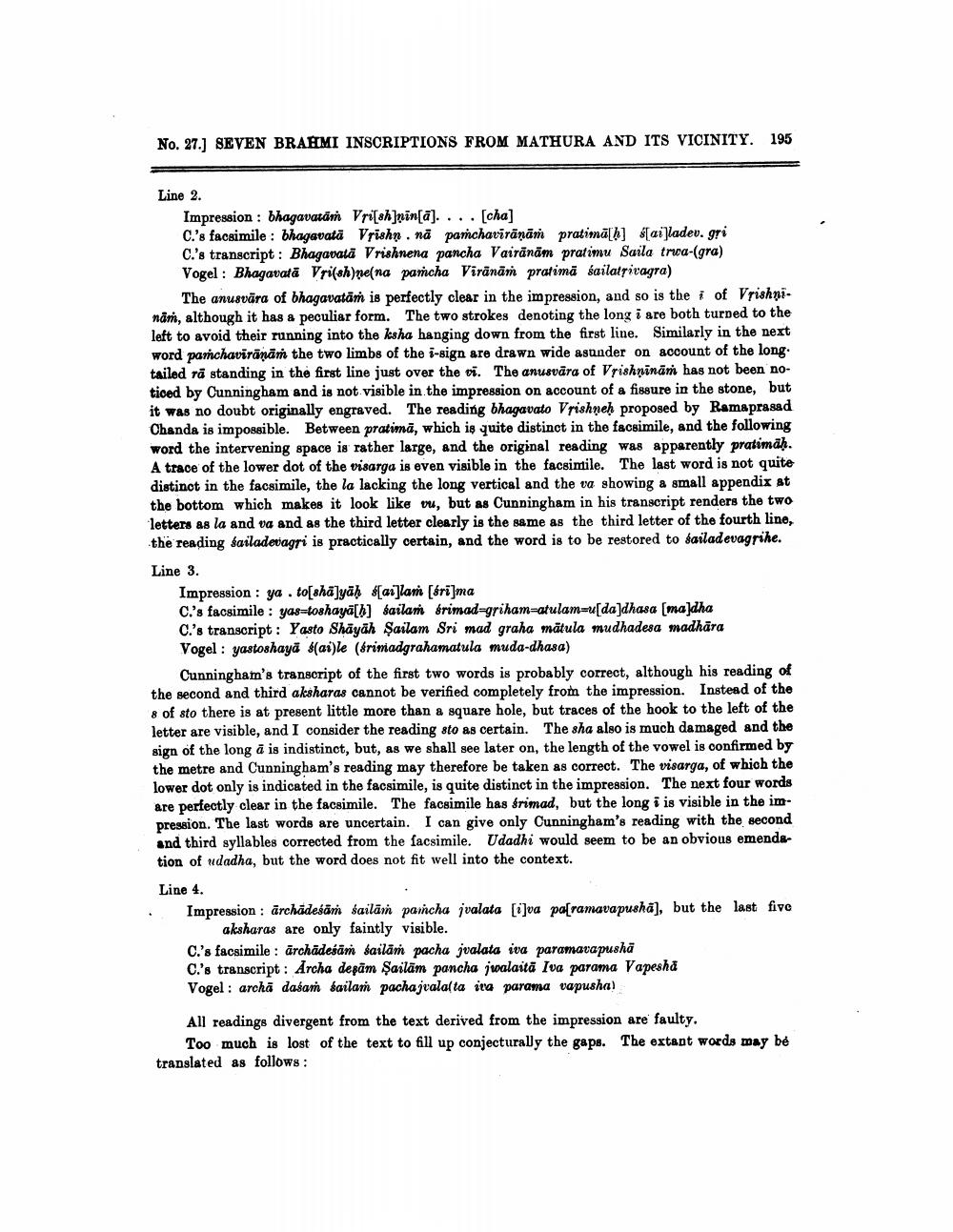________________
No. 27.) SEVEN BRAHMI INSCRIPTIONS FROM MATHURA AND ITS VICINITY. 195
Line 2.
Impression : bhagavatán Vri[sh]nin[a].... (cha) C's facsimile : bhagavata Vrishn.nă parchaviränāṁ pratimālhl sailladev. gri C.'s transcript : Bhagavata Vrishnena pancha Vairānām pratimu Saila trwa-(gra) Vogel : Bhagavatā Vri(sh)nena pańcha Virānām pratimā sailatsivagra)
The anusvāra of bhagavatām is perfectly clear in the impression, and so is the i of Vrishninär, although it has a peculiar form. The two strokes denoting the long i are both turned to the left to avoid their running into the ksha hanging down from the first line. Similarly in the next word parchavīrānāṁ the two limbs of the 2-sign are drawn wide asunder on account of the long tailed rā standing in the first line just over the vi. The anusvāra of Vrishnināṁ has not been notioed by Cunningham and is not visible in the impression on account of a fissure in the stone, but it was no doubt originally engraved. The reading bhagavato Vrishneh proposed by Ramaprasad Chanda is impossible. Between pratima, which is quite distinct in the facsimile, and the following word the intervening space is rather large, and the original reading was apparently pratimah. A trace of the lower dot of the visarga is even visible in the facsimile. The last word is not quite distinct in the facsimile, the la lacking the long vertical and the va showing a small appendix at the bottom which makes it look like vu, but as Cunningham in his transcript renders the two letters as la and va and as the third letter clearly is the same as the third letter of the fourth line, the reading sailadevagri is practically certain, and the word is to be restored to bailadevagrihe. Line 3.
Impression: ya . to[shā]yāḥ f[ar]lam [6ri]ma CI's facsimile : yas=toshayā[h] sailar Srimad=griham-atulam-u[da]dhasa (ma]dha C's transcript : Yasto Shāyah Şailam Sri mad graha mätula mudhadesa madhara Vogel : yastoshayā (ai)le (érimadgrahamatula muda-dhasa)
Cunningham's transcript of the first two words is probably correct, although his reading of the second and third aksharas cannot be verified completely from the impression. Instead of the 8 of sto there is at present little more than a square hole, but traces of the hook to the left of the letter are visible, and I consider the reading sto as certain. The sha also is much damaged and the sign of the long ā is indistinct, but, as we shall see later on, the length of the vowel is confirmed by the metre and Cunningham's reading may therefore be taken as correct. The visarga, of which the lower dot only is indicated in the facsimile, is quite distinct in the impression. The next four words are perfectly clear in the facsimile. The facsimile has srimad, but the long i is visible in the impression. The last words are uncertain. I can give only Cunningham's reading with the second and third syllables corrected from the facsimile. Udadhi would seem to be an obvious emendation of dadha, but the word does not fit well into the context. Line 4. Impression : archädešām sailām paincha jvalata [Jva pa[ramavapusha], but the last five
aksharas are only faintly visible. C's facsimile: archädešām sailam pacha jualata iva paramara pushā C.'s transcript : Archa depām Şailām pancha jwalaitā Iva parama Vapesha Vogel : archa dasan sailam pachajvalalta ira parama vapushal
All readings divergent from the text derived from the impression are faulty.
Too much is lost of the text to fill up conjecturally the gaps. The extant words may be translated as follows:




